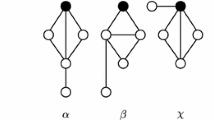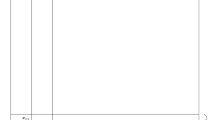We treat the probabilistic notion of unimodularity for measures on the space of rooted, locally finite, connected graphs in terms of the theory of measured equivalence relations. It turns out that the right framework for this consists in considering quasi-invariant (rather than just invariant) measures with respect to the root moving equivalence relation. We define a natural modular cocycle of this equivalence relation and show that unimodular measures are precisely those quasi-invariant measures whose Radon–Nikodym cocycle coincides with the modular cocycle. This embeds the notion of unimodularity into a very general dynamical scheme of constructing and studying measures with a prescribed Radon–Nikodym cocycle.
Similar content being viewed by others
References
D. Aldous and R. Lyons, “Processes on unimodular random networks,” Electron. J. Probab., 12, 1454–1508 (2007) (electronic).
D. Aldous and J. M. Steele, “The objective method: probabilistic combinatorial optimization and local weak convergence,” in: Probability on Discrete Structures, Encyclopaedia Math. Sci., 110, Springer, Berlin (2004), pp. 1–72.
M. Aizenman and S. Warzel, “The canopy graph and level statistics for random operators on trees,” Math. Phys. Anal. Geom., 9, 291–333 (2006).
I. Benjamini and N. Curien, “Ergodic theory on stationary random graphs,” Electron. J. Probab., 17, No. 93, 20 pp. (2012) (electronic).
H. Bass and A. Lubotzky, Tree Lattices, Progress in Mathematics, 176, With appendices by H. Bass, L. Carbone, Lubotzky, G. Rosenberg, and J. Tits, Birkhäuser Boston, Inc., Boston, MA (2001).
I. Benjamini, R. Lyons, Y. Peres, and O. Schramm, “Group-invariant percolation on graphs,” Geom. Funct. Anal., 9, 29–66 (1999).
I. Benjamini, R. Lyons, and O. Schramm, “Unimodular random trees,” Ergodic Theory Dynam. Systems, 35, 359–373 (2015).
R. Bowen, “Equilibrium states and the ergodic theory of Anosov diffeomorphisms,” Lect. Notes Math., 470, Springer, Berlin–New York (1975).
I. Benjamini and O. Schramm, “Recurrence of distributional limits of finite planar graphs,” Electron. J. Probab., 6, No. 23, 13 pp. (2001) (electronic).
L. Carbone, Non-uniform Lattices on Uniform Trees, Mem. Amer. Math. Soc., 152, No. 724, xii+127 (2001).
D. I. Cartwright, V. A. Kaimanovich, and W. Woess, “Random walks on the affine group of local fields and of homogeneous trees,” Ann. Inst. Fourier (Grenoble), 44, 1243–1288 (1994).
L. Carbone and G. Rosenberg, “Lattices on nonuniform trees,” Geom. Dedicata, 98, 161–188 (2003).
J. Feldman and C. C. Moore, “Ergodic equivalence relations, cohomology, and von Neumann algebras. I,” Trans. Amer. Math. Soc., 234, 289–324 (1977).
L. Garnett, “Foliations, the ergodic theorem and Brownian motion,” J. Funct. Anal., 51, 285–311 (1983).
O. Häggström, “Infinite clusters in dependent automorphism invariant percolation on trees,” Ann. Probab., 25, 1423–1436 (1997).
F. Harary, “Methods of destroying the symmetries of a graph,” Bull. Malays. Math. Sci. Soc. (2), 24, 183–191 (2001).
F. Harary and D. Ranjan, “Breaking symmetry in complete graphs by orienting edges: asymptotic bounds,” Inform. Process. Lett., 67, 227–230 (1998).
V. A. Kaimanovich, “Brownian motion on foliations: entropy, invariant measures, mixing,” Funkts. Anal. Prilozhen., 22, 82–83 (1988).
V. A. Kaimanovich, “Measure-theoretic boundaries of Markov chains, 0-2 laws, and entropy,” in: Harmonic Analysis and Discrete Potential Theory (Frascati, 1991), Plenum, New York (1992), pp. 145–180.
V. A. Kaimanovich, “Hausdorff dimension of the harmonic measure on trees,” Ergodic Theory Dynam. Systems, 18, 631–660 (1998).
V. A. Kaimanovich, “Random walks on Sierpiński graphs: hyperbolicity and stochastic homogenization,” in: Fractals in Graz 2001, Trends Math., Birkhäuser, Basel (2003), pp. 145–183.
V. A. Kaimanovich, “Amenability and the Liouville property,” Israel J. Math., 149, 45–85 (2005).
V. A. Kaimanovich, “Hopf decomposition and horospheric limit sets,” Ann. Acad. Sci. Fenn. Math., 35, 335–350 (2010).
V. A. Kaimanovich and M. Lyubich, Conformal and Harmonic Measures on Laminations Associated With Rational Maps, Mem. Amer. Math. Soc., 173, No. 820, vi+119 (2005).
V. A. Kaimanovich and W. Woess, “Construction of discrete, nonunimodular hypergroups,” in: Probability Measures on Groups and Related Structures, XI (Oberwolfach, 1994), World Sci. Publ., River Edge, NJ (1995) pp. 196–209.
V. A. Kaimanovich and W. Woess, “Boundary and entropy of space homogeneous Markov chains,” Ann. Probab., 30, 323–363 (2002).
R. Lyons, R. Pemantle, and Yu. Peres, “Ergodic theory on Galton–Watson trees: speed of random walk and dimension of harmonic measure,” Ergodic Theory Dynam. Systems, 15, 593–619 (1995).
J. R. Norris, Markov Chains, Cambridge Series in Statistical and Probabilistic Mathematics, 2, Cambridge Univ. Press, Cambridge (1998) (Reprint of the 1997 original).
F. Paulin, “Propriétés asymptotiques des relations d’équivalences mesurées discrétes,” Markov Process. Related Fields, 5, 163–200 (1999).
M. Rosenblatt, Markov Processes. Structure and Asymptotic Behavior, Springer–Verlag, New York (1971).
M. A. Ronan and J. Tits, “Twin trees. II. Local structure and a universal construction,” Israel J. Math., 109, 349–377 (1999).
G. Schlichting, “Polynomidentitäten und Permutationsdarstellungen lokalkompakter Gruppen,” Invent. Math., 55, 97–106 (1979).
Ya. G. Sinai, “Gibbs measures in ergodic theory,” Usp. Mat. Nauk, 27, No. 4 (166), 21–64 (1972).
D. Sullivan, “The density at infinity of a discrete group of hyperbolic motions,” Inst. Hautes Études Sci. Publ. Math., No. 50, 171–202 (1979).
P. M. Soardi and W. Woess, “Amenability, unimodularity, and the spectral radius of random walks on infinite graphs,” Math. Z., 205, 471–486 (1990).
V. I. Trofimov, “Groups of automorphisms of graphs as topological groups,” Mat. Zametki, 38, 378–385 (1985).
W. T. Tutte, “A census of planar triangulations,” Canad. J. Math., 14, 21–38 (1962).
W. T. Tutte, “On the enumeration of convex polyhedra,” J. Combin. Theory Ser. B, 28, 105–126 (1980).
W. Woess, “Topological groups and recurrence of quasitransitive graphs,” Rend. Sem. Mat. Fis. Milano, 64, 185–213 (1994).
W. Woess, Random Walks on Infinite Graphs and Groups, Cambridge Tracts in Mathematics, 138, Cambridge Univ. Press, Cambridge (2000).
Author information
Authors and Affiliations
Corresponding author
Additional information
Translated from Zapiski Nauchnykh Seminarov POMI, Vol. 441, 2015, pp. 210–238.
Rights and permissions
About this article
Cite this article
Kaimanovich, V.A. Invariance, Quasi-Invariance, and Unimodularity for Random Graphs. J Math Sci 219, 747–764 (2016). https://doi.org/10.1007/s10958-016-3144-z
Received:
Published:
Issue Date:
DOI: https://doi.org/10.1007/s10958-016-3144-z




